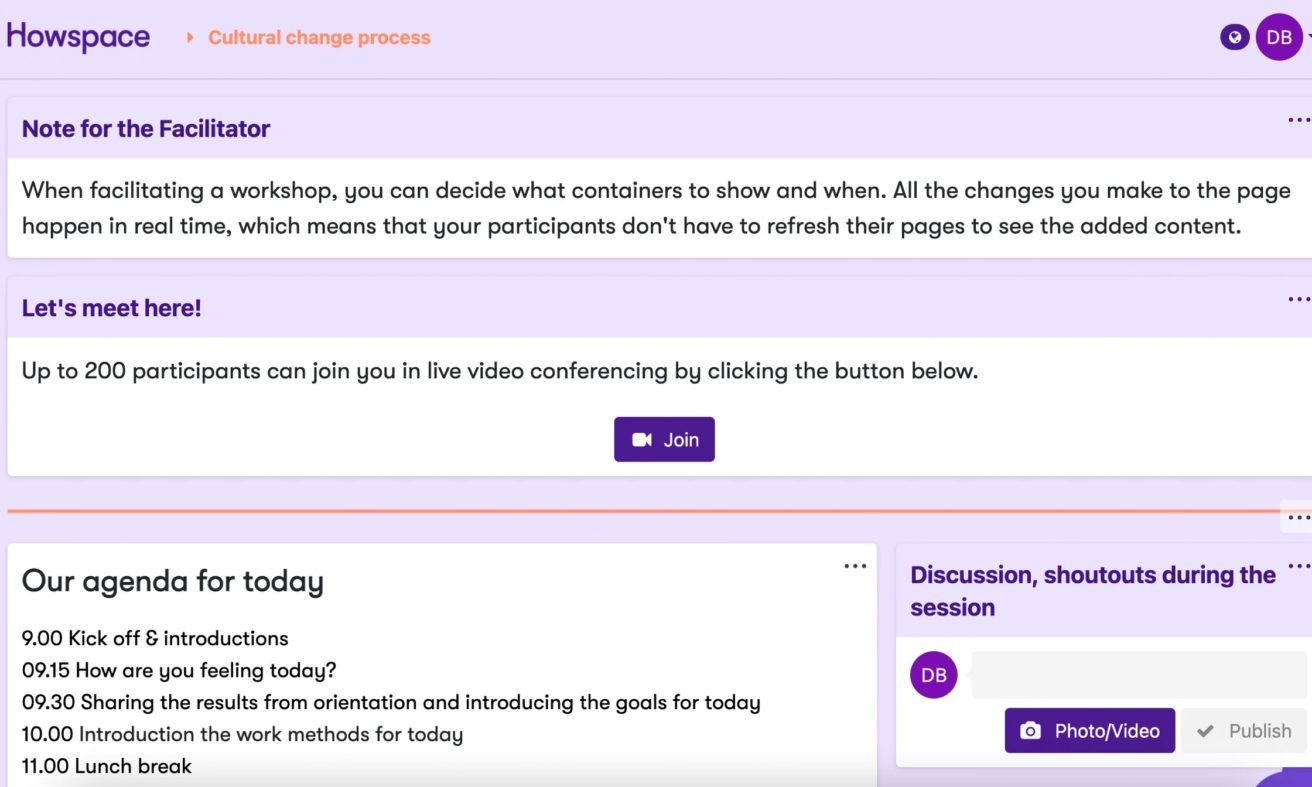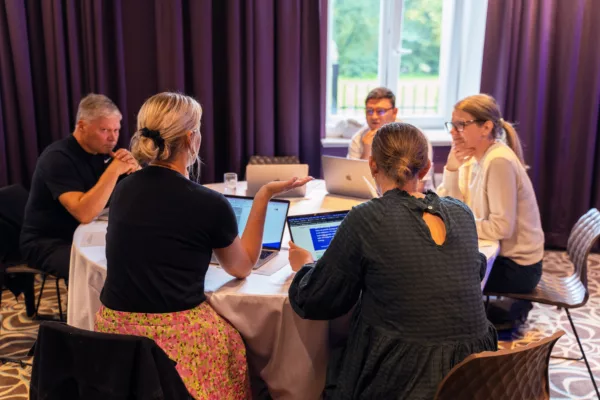
Top 7 Virtual Organizational Transformation Strategies
When it comes to organizational transformation strategies and how to effectively lead change in a virtual environment, my pro tip is to keep in mind that change should never be managed. Instead, I recommend focusing on organizational transformation strategies that invite people to contribute to change and become active transformation agents.
In this blog, I will introduce the top 7 organizational transformation strategies that you can apply in a virtual environment. I’ve gathered this list from my discussions with organizational development (OD) and transformation consultants, practitioners, and experts.
Here are the 7 organizational transformation strategies I will focus on:
2. Invite all stakeholders to build the strategy
7. Leverage the right digital platforms and tools
1. Start with why
Before you can expect anyone to commit to any organizational change or development initiatives, you must first help them understand why it exists and why you’re approaching it in a certain way. The “why” should represent the big picture.
The most powerful form of “why” supports the purpose of the organization — it is not only rational and based on facts — but also needs to be connected to higher levels of being human. Storytelling is an excellent way to communicate the why.
It’s important to clearly articulate the “what is changing” story, to accelerate awareness and understanding. This can be tricky in a remote environment, where you can lose some of the connection that is inherent to face-to-face situations. Utilizing supportive online tools, regular two-way communication, and the organizational transformation strategies presented below will help create a positive user experience in a virtual environment.
Remember, instead of simply sticking to a single “why”, you should help people find also their own drivers. A single change process will most likely have different outcomes, so why not let people focus on the ones that matter to them the most?
Even if the top management communicates the why, you should leave opportunities for multiple perspectives and personal insights. If you leave the why as “the final single truth,” people will easily start resisting change.
That’s why it’s critical to let employees know how they will personally benefit from the transformation initiative—how it will make their jobs easier or help their career development—as well as how it will take the organization to the next level.
2. Invite all stakeholders to build the strategy
When organizational transformation strategies and execution of change are run as two separate streams, you’re much more likely to encounter resistance during execution. To avoid this pitfall, invite all stakeholders to share their ideas, hopes, and dreams before you even start crafting the strategy. And remember, that might include customers and other external stakeholders as well.
This approach is called human-centric transformation, which simply means that you invite people to be an essential part of a transformation process.
To do this easily online, create a dedicated virtual workspace, where you can cut out all the other noise and distractions, and focus on the initiative at hand. We recommend using an all-in-one transformation design and execution platform like Howspace, which was specifically created for managing organizational development and transformation programs in a virtual environment.
3. Co-create
If there’s one key takeaway I’d like you to take from this, it’s focusing on co-creation. Co-creation is a strategy that invites practically an entire organization and its stakeholders to jointly produce a mutually valued outcome.
As with the previous strategy, start co-creation as early as possible in the process, not just at the implementation phase.
With traditional change management models, transformation strategy is reserved for the management team and sometimes external consultants, while the rest of the employees are not invited to the table. As a result, many valuable ideas will never be heard. So whether you are a consultant or a leader driving the transformation, remember to include all voices in the process.
Co-creation calls for participative leadership or collaborative leadership, where all members of an organization work together to make decisions. Co-creation allows employees to affect their own work environment and be part of making meaningful change. These experiences strengthen employees’ self- and collective efficacy as change agents (or as transformation agents as we at Howspace like to say), which is a strong predictor of future performance.
Change is a journey, so it’s crucial to keep everyone involved throughout the process. And keeping people involved doesn’t mean you need to have meetings or synchronous collaboration, instead, individuals can take part a few minutes here and there on their own time. Just remember to provide enough context and clear instructions for how people can participate. The experience of being part of the journey raises the level of engagement exponentially and helps prevent individuals from wanting to drop out of the process.
And remember, co-creation doesn’t need to end within your own organization. The power of co-creation can be extended to your customers to ideate, produce, and market products. Companies like Apple, Ikea, Nike, Unilever, and Heineken have successfully engaged their stakeholders (mainly customers) in co-creation initiatives.
4. Give everyone a voice
One of the best things about a virtual environment is that there is no limit to how many people can participate, where they’re participating from, or when they decide to provide input. However, we can all empathize with how difficult it is to involve each member of a large and diverse organization in any process — let alone a complex and strategic one that involves organizational change and transformation.
This is where a virtual environment can really flourish. Utilizing effective communication and collaboration tools gives everyone an opportunity to participate and voice their opinions and ideas. I know that some of my best ideas hit me long after a meeting has ended after I’ve had time to process all the information. When there’s a central hub for communication, I can voice those ideas at any time, from anywhere, and even directly from my mobile phone.
People like to collaborate and learn in different ways. To truly involve all individuals within a large and diverse group there needs to be multiple ways to enable participation. By allowing people to communicate not only in person but also in writing, through pictures, and even through video, you’ll be able to truly benefit from everyone’s point of view.
To take it a step further, on certain online platforms, participants can also be made anonymous. This means even the shyest people can contribute. You can even take involvement further than that and break down language barriers by’ allowing users to participate in their own language if the platform supports real-time translations. With the new Howspace Translations feature you can already translate the workspace into 25 languages.
On an online collaboration platform, it’s easy to have small team or ad hoc group discussions, but the real power is utilizing a virtual platform to involve an entire organization. Having a digital facilitator really helps the process as it’s their job to let everyone’s voices be heard.
A prime example of this is when Toronto Change Days wanted to bring together over 80 change professionals from all over the world and create an immersive festival of change, rather than an event with static Powerpoint decks and one-way presentations.
Howspace was brought in to facilitate the conversations. It was used before the conference to share the agenda and allow facilitators to start engaging with the participants. During the conference, people utilized Howspace to participate in discussions and share feedback on workshops. Over the course of the 3-day conference, most participants visited the platform at least once. But it didn’t end there. After the conference ended, Howspace became a venue for sharing insight, and a launchpad for building a community of practice to keep the spirit of the conference alive.
5. Facilitate, don’t dictate
As mentioned earlier, change shouldn’t be managed but instead, it should be facilitated. Perhaps the most important skill any transformation lead or consultant can possess is the ability to give a voice to all the participants (case in point strategy #4). In other words, you’ll want to guide the conversation and empower individuals to use the chosen virtual transformation platform to drive deep lasting impact.
It can be difficult to create natural dialogue in a virtual meeting. That’s why it is important that the virtual platform you choose to design and execute the transformation, provides you the conditions to create a dialogue between the participants in a simple and clear way. Different topics should be sorted so that everything is not mixed or lost in a single conversation thread.
When discussions get overwhelming, I love leveraging the power of Howspace’s real-time AI to quickly generate summaries and theme clusters of massive amounts of input. You can have as many participants as you like (tens of thousands and beyond) sharing their comments and have the AI helping you sort out the comments as you go.
Productive co-creative interaction requires some basic skills from facilitators and participants, but it’s something that can be easily learned. Organizations just need to be willing to make facilitation skills available to employees through training and practice.
A fantastic way to continually develop your team’s facilitation skills is to gather all meeting leaders at a regular cadence to jointly build a common knowledge bank. There are also courses available for polishing your digital facilitation skills, such as our very own Introduction to Digital Facilitation course.
6. Be transparent and agile
To implement an organizational transformation strategy successfully, communication and transparency are vital but they are some of the toughest issues organizations face.
Trusting people helps make the organization more trustful and being brave with transparency is an important part of trust building.
Another advantage of a virtual environment is the opportunity to make communication, processes, and decisions transparent. When utilizing a single platform for organizational transformation and development initiatives, all discussions, ideas, and solutions can be gathered in a single place. This makes insight gathering, analysis, and follow-up so much easier, agile, and transparent.
Each organization’s process is different, which is why it’s important to stay open to feedback and iterate as you go along. Platforms that allow you to design and tailor the transformation journey to the changing needs give you the opportunity and flexibility to stay agile. No transformation or change process is ever linear. Highly collaborative organizations recognize that change is a perpetual state in their organizations and adapt and evolve as needed.
7. Leverage the right digital platforms and tools
The most successful organizations formulate a strategy (the “why” and “how” of change for their organization) before rushing to buy the latest solution or platform. The technology should support the strategy.
Whether you are a leader looking for technical and virtual solutions to drive your transformation and organizational development programs in-house, or an IT consultant or management consultant looking to find the right solution for you to support your clients with their transformation or cultural transformation, remember to always take the perspective of the participant experience.
When you’re ready to decide, find the right platforms and tools that are simple to use, flexible, and provide a noiseless space to focus on the program at hand.
Wrapping up
Before setting out to test out these approaches to organizational transformation strategies, I’d like to leave you with a couple of questions you can ask yourself. After all, I did suggest starting with why.
1. Are you leading by example?
When you think about the outcome you are aiming at, the way you lead and the way you get there should be applied to the change process. For example, if you’d like to be a more collaborative organization, then you can’t expect transformative ideas to only come from a limited group of people.
2. Do the tools you are using support your organizational transformation strategies?
Often companies are using multiple tools, which can easily lead to the creation of silos among teams and individuals. If you’d like to provide more transparency, and opportunities for co-creation, and facilitate dialogue among the employees, then it’s critical to have a single virtual platform that supports this.
Check out our free template Leading a Change Process! This practical process template walks you through the whole process of involvement-based cultural change from communicating the need for change to integrating it into the day-to-day.
Already a Howspace-user? You can add the template to your account here.

You might be interested in these as well
View all
Make Your Decision-Making More Inclusive and Effective
Participatory decision-making taps into the collective wisdom of your entire workforce. Here’s how to make more impactful decisions in your organization.

The best change management tools for successful organizational transformation
Embracing change within organizations can be challenging, as people naturally resist it. However, utilizing the right change management software can […]

Top 7 Virtual Organizational Transformation Strategies
When it comes to organizational transformation strategies and how to effectively lead change in a virtual environment, my pro tip […]